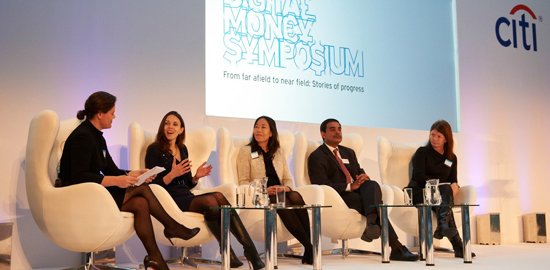by Citi
Two key themes shone through in every discussion of the third annual Digital Money Symposium: adaptation, and collaboration. The digital environment is too great and too complex for any one company, or sector, to dominate. Instead, we need to create a digital-money ecosystem – adapting to the new environment, and sharing capabilities and expertise across industries.
The digital revolution is very much underway, and — as the 2015 Digital Money Symposium highlighted — companies, financial institutions, governments and consumers have a choice: adapt, or fall behind. Hosted by Citi and Imperial College London, the Symposium discussed stories of progress, and examined the need for adaptation and collaboration as the key ingredients for the hard work ahead of digitally- converting the remaining — and stubbornly resistant — physical cashflows. Indeed, through bringing together representatives from all sectors — with speeches from those at Citi, Imperial College London, GSM Association, Verifone, Transport for London, mySupermarket, Google Fiber, Zopa, The Financial Times, Financial Conduct Authority and Bitcoin — the symposium invited players to explore how collaboration can build a digital ecosystem that is large and profitable enough to benefit us all. Across the two panel discussions and keynote speeches, the symposium — held at London’s City Hall — focused on five key areas: the benefits of digital money; the Digital Money Index — highlighting a need for adaptation; connecting the unconnected; stories of progress; and industrialisation versus innovation.
1. The benefits of digital money
Increasing the pie: adding to the formal economy
- The benefits of digital money adoption are clear. “The consensus is that digital money is better, cheaper, faster,” described Jamie Forese, Co-President of Citi and Head of the Institutional Clients Group.
- “Just a 10 percent increase in digital-money adoption could generate an additional US$1 trillion for the formal economy — through the financial inclusion of around 220 million people,” explained Forese in the Symposium’s opening remarks.
- “This would have a ripple-effect,” added Sandeep Davé, Director of Global Digital Strategy at Citi. “Governments would see US$100 billion in additional taxes, banks would see new loan and deposit relationships to the tune of US$150 billion, and retailers would see an increase in spending power to US$100 billion.”
Reducing costs
Sign up for free to read the full article
Register Login with LinkedInAlready have an account?
Login
Download our Free Treasury App for mobile and tablet to read articles – no log in required.
Download Version Download Version





























